tow LINCOLN MKC 2015 Workshop Manual
[x] Cancel search | Manufacturer: LINCOLN, Model Year: 2015, Model line: MKC, Model: LINCOLN MKC 2015Pages: 490, PDF Size: 4.74 MB
Page 247 of 490
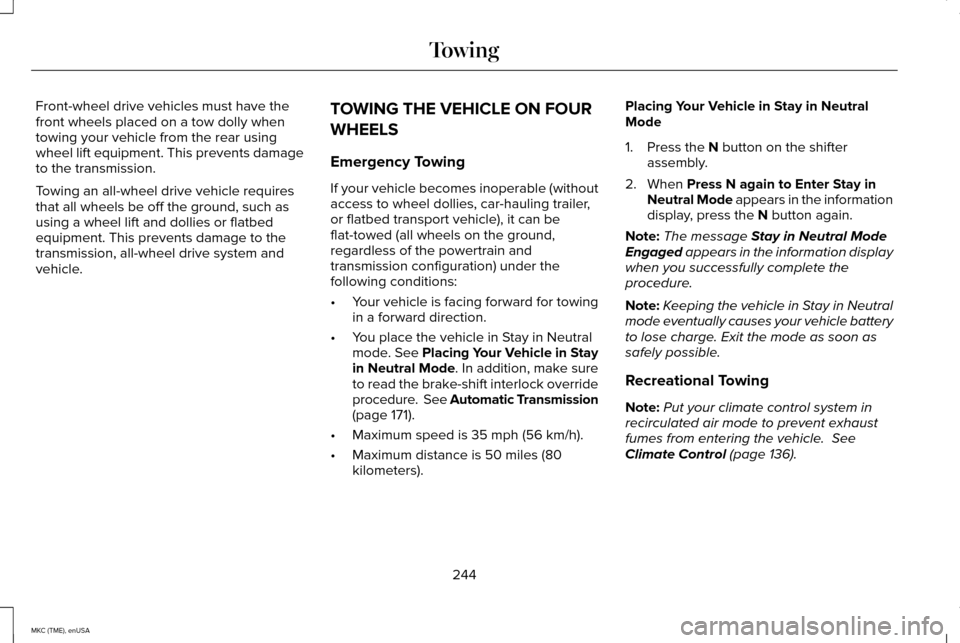
Front-wheel drive vehicles must have the
front wheels placed on a tow dolly when
towing your vehicle from the rear using
wheel lift equipment. This prevents damage
to the transmission.
Towing an all-wheel drive vehicle requires
that all wheels be off the ground, such as
using a wheel lift and dollies or flatbed
equipment. This prevents damage to the
transmission, all-wheel drive system and
vehicle.
TOWING THE VEHICLE ON FOUR
WHEELS
Emergency Towing
If your vehicle becomes inoperable (without
access to wheel dollies, car-hauling trailer,
or flatbed transport vehicle), it can be
flat-towed (all wheels on the ground,
regardless of the powertrain and
transmission configuration) under the
following conditions:
•
Your vehicle is facing forward for towing
in a forward direction.
• You place the vehicle in Stay in Neutral
mode. See Placing Your Vehicle in Stay
in Neutral Mode. In addition, make sure
to read the brake-shift interlock override
procedure. See Automatic Transmission
(page 171).
• Maximum speed is 35 mph (56 km/h).
• Maximum distance is 50 miles (80
kilometers). Placing Your Vehicle in Stay in Neutral
Mode
1. Press the
N button on the shifter
assembly.
2. When
Press N again to Enter Stay in
Neutral Mode appears in the information
display, press the
N button again.
Note: The message
Stay in Neutral Mode
Engaged appears in the information display
when you successfully complete the
procedure.
Note: Keeping the vehicle in Stay in Neutral
mode eventually causes your vehicle battery
to lose charge. Exit the mode as soon as
safely possible.
Recreational Towing
Note: Put your climate control system in
recirculated air mode to prevent exhaust
fumes from entering the vehicle.
See
Climate Control (page 136).
244
MKC (TME), enUSA Towing
Page 248 of 490
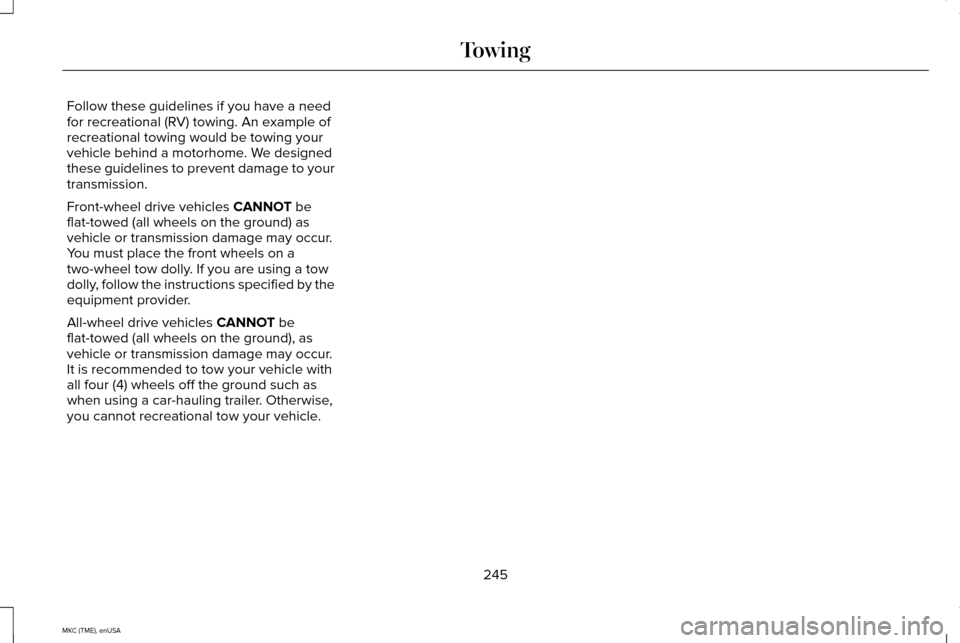
Follow these guidelines if you have a need
for recreational (RV) towing. An example of
recreational towing would be towing your
vehicle behind a motorhome. We designed
these guidelines to prevent damage to your
transmission.
Front-wheel drive vehicles CANNOT be
flat-towed (all wheels on the ground) as
vehicle or transmission damage may occur.
You must place the front wheels on a
two-wheel tow dolly. If you are using a tow
dolly, follow the instructions specified by the
equipment provider.
All-wheel drive vehicles
CANNOT be
flat-towed (all wheels on the ground), as
vehicle or transmission damage may occur.
It is recommended to tow your vehicle with
all four (4) wheels off the ground such as
when using a car-hauling trailer. Otherwise,
you cannot recreational tow your vehicle.
245
MKC (TME), enUSA Towing
Page 249 of 490
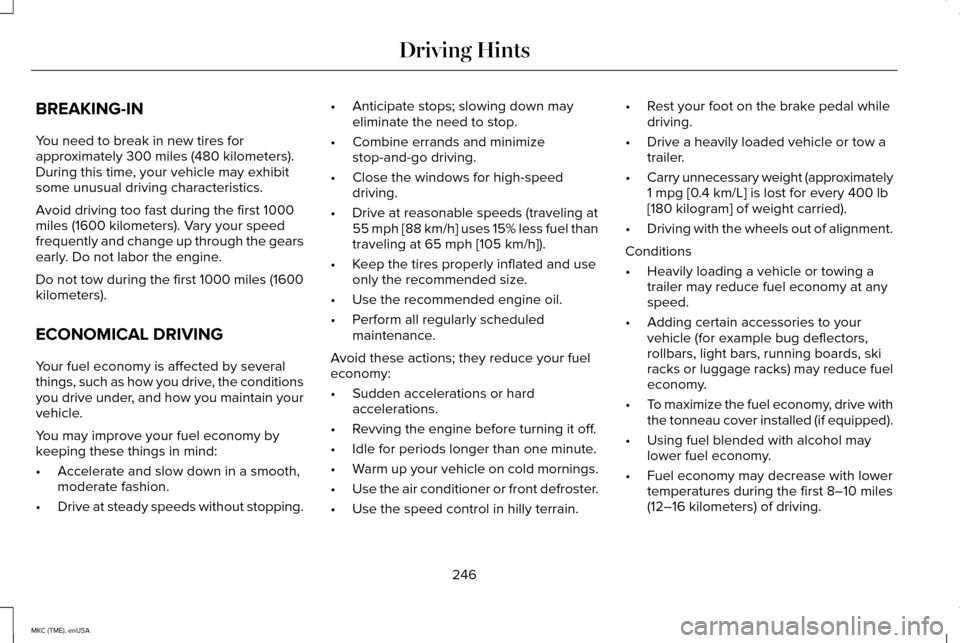
BREAKING-IN
You need to break in new tires for
approximately 300 miles (480 kilometers).
During this time, your vehicle may exhibit
some unusual driving characteristics.
Avoid driving too fast during the first 1000
miles (1600 kilometers). Vary your speed
frequently and change up through the gears
early. Do not labor the engine.
Do not tow during the first 1000 miles (1600
kilometers).
ECONOMICAL DRIVING
Your fuel economy is affected by several
things, such as how you drive, the conditions
you drive under, and how you maintain your
vehicle.
You may improve your fuel economy by
keeping these things in mind:
•
Accelerate and slow down in a smooth,
moderate fashion.
• Drive at steady speeds without stopping. •
Anticipate stops; slowing down may
eliminate the need to stop.
• Combine errands and minimize
stop-and-go driving.
• Close the windows for high-speed
driving.
• Drive at reasonable speeds (traveling at
55 mph [88 km/h] uses 15% less fuel than
traveling at 65 mph [105 km/h]).
• Keep the tires properly inflated and use
only the recommended size.
• Use the recommended engine oil.
• Perform all regularly scheduled
maintenance.
Avoid these actions; they reduce your fuel
economy:
• Sudden accelerations or hard
accelerations.
• Revving the engine before turning it off.
• Idle for periods longer than one minute.
• Warm up your vehicle on cold mornings.
• Use the air conditioner or front defroster.
• Use the speed control in hilly terrain. •
Rest your foot on the brake pedal while
driving.
• Drive a heavily loaded vehicle or tow a
trailer.
• Carry unnecessary weight (approximately
1 mpg [0.4 km/L] is lost for every 400 lb
[180 kilogram] of weight carried).
• Driving with the wheels out of alignment.
Conditions
• Heavily loading a vehicle or towing a
trailer may reduce fuel economy at any
speed.
• Adding certain accessories to your
vehicle (for example bug deflectors,
rollbars, light bars, running boards, ski
racks or luggage racks) may reduce fuel
economy.
• To maximize the fuel economy, drive with
the tonneau cover installed (if equipped).
• Using fuel blended with alcohol may
lower fuel economy.
• Fuel economy may decrease with lower
temperatures during the first 8–10 miles
(12–16 kilometers) of driving.
246
MKC (TME), enUSA Driving Hints
Page 252 of 490

ROADSIDE ASSISTANCE
Vehicles Sold In the United States:
Getting Roadside Assistance
To fully assist, if you have a vehicle concern,
Ford Motor Company offers a complimentary
Roadside Assistance program. This program
is separate from the New Vehicle Limited
Warranty.
The service is available:
•
24 hours a day, seven days a week.
• Throughout the life of the vehicle for
original owners only.
• For 6 years or 70,000.0 mi
(112,654.08 km) (whichever comes first)
within the extended powertrain warranty
coverage period for subsequent owners.
Roadside assistance will cover:
• A flat tire change with a good spare
(except vehicles supplied with a tire
inflation kit).
• Battery jump start.
• Lock-out assistance (key replacement
cost is the client's responsibility). •
Fuel delivery — independent service
contractors, if not prohibited by state,
local or municipal law shall deliver up to
2.00 gal (7.57 L)
of gasoline or 5.00 gal
(18.93 L) of diesel fuel to a disabled
vehicle. Roadside Assistance limits fuel
delivery service to two no-charge
occurrences within a 12-month period.
• Winch out — available within
100.0 ft
(30.48 m) of a paved or county
maintained road, no recoveries.
• Towing — Lincoln eligible vehicles to the
client's selling or preferred dealer within
100.0 mi (161 km)
of the disablement
location or to the nearest Lincoln dealer.
If a client requests a tow to a selling or
preferred dealer that is more than
100.0 mi (161 km)
from the disablement
location, the client shall be responsible
for any mileage costs in excess of
100.0 mi (161 km)
. Roadside Assistance will include up to $200
coverage for a towed trailer if the disabled
eligible vehicle requires service at the
nearest authorized dealer. If the towing
vehicle is operational but the trailer is not,
then the trailer does not qualify for any
roadside services.
Vehicles Sold In the United States:
Using Roadside Assistance
United States Lincoln vehicle clients who
require Roadside Assistance, call
1-800-521-4140.
If you need to arrange roadside assistance
for yourself, Ford Motor Company will
reimburse a reasonable amount for towing
to the nearest Lincoln dealership within
100.0 mi (161 km)
. To obtain reimbursement
information, United States Lincoln vehicle
clients, call 1-800-521-4140. Ford Motor
Company will ask you to submit your original
receipts.
249
MKC (TME), enUSA Roadside Emergencies
Page 266 of 490
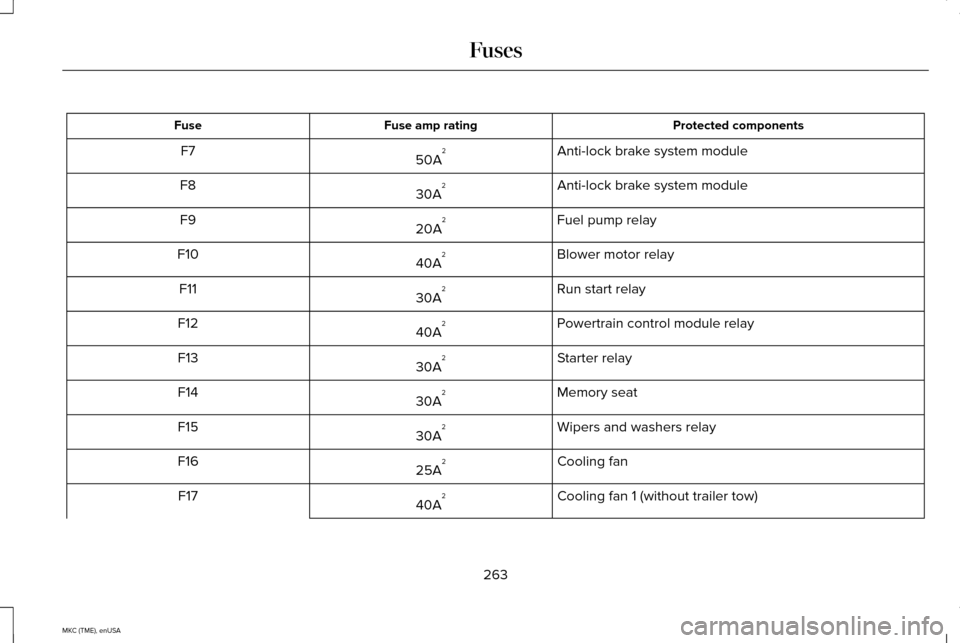
Protected components
Fuse amp rating
Fuse
Anti-lock brake system module
50A 2
F7
Anti-lock brake system module
30A 2
F8
Fuel pump relay
20A 2
F9
Blower motor relay
40A 2
F10
Run start relay
30A 2
F11
Powertrain control module relay
40A 2
F12
Starter relay
30A 2
F13
Memory seat
30A 2
F14
Wipers and washers relay
30A 2
F15
Cooling fan
25A 2
F16
Cooling fan 1 (without trailer tow)
40A 2
F17
263
MKC (TME), enUSA Fuses
Page 267 of 490

Protected components
Fuse amp rating
Fuse
Cooling fan 1 (with trailer tow)
50A 2
Cooling fan 2 (without trailer tow)
40A 2
F18
Cooling fan 2 (with trailer tow)
50A 2
Anti-lock brake system module run/start
5A 1
F19
Horn relay
20A 1
F20
Brake pedal switch
10A 1
F21
Windshield wipers and washer
25A 1
F22
Run/start relay coil
5A 1
F23
Transmission range control module
20A 1
F24
Air conditioning clutch relay
10A 1
F25
Powertrain control module relay coil
5A 1
F26
Washer pump relay
10A 1
F27
264
MKC (TME), enUSA Fuses
Page 270 of 490
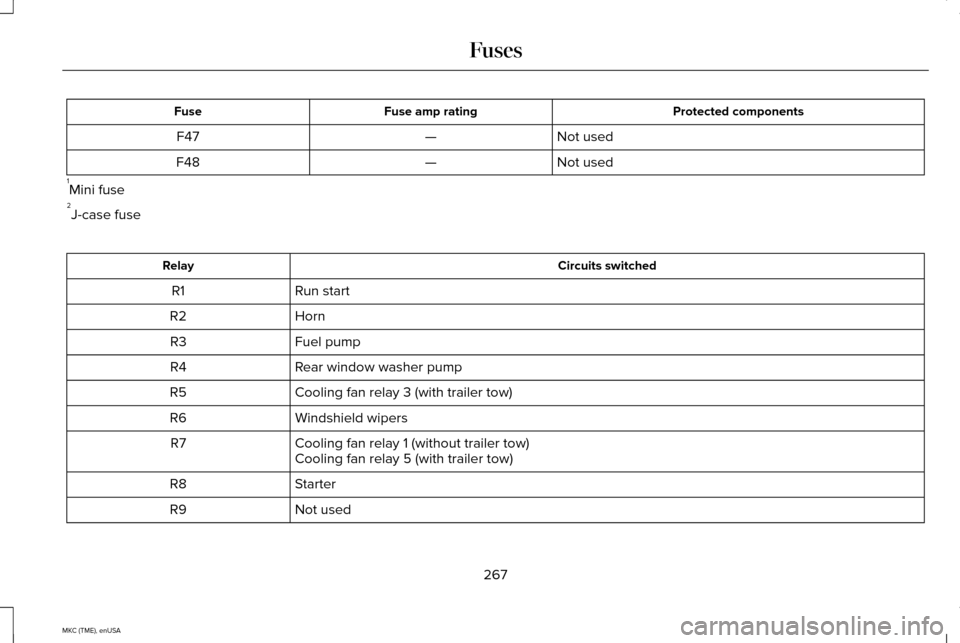
Protected components
Fuse amp rating
Fuse
Not used
—
F47
Not used
—
F48
1 Mini fuse
2 J-case fuse Circuits switched
Relay
Run start
R1
Horn
R2
Fuel pump
R3
Rear window washer pump
R4
Cooling fan relay 3 (with trailer tow)
R5
Windshield wipers
R6
Cooling fan relay 1 (without trailer tow)
R7
Cooling fan relay 5 (with trailer tow)
Starter
R8
Not used
R9
267
MKC (TME), enUSA Fuses
Page 271 of 490

Circuits switched
Relay
Cooling fan relay 4 (with trailer tow)
R10
Air conditioning clutch
R11
Cooling fan relay 1 (with trailer tow)
R12
Cooling fan relay 3 (without trailer tow)
Cooling fan relay 2
R13
Powertrain control module
R14
Heated rear window
R15
Blower motor
R16
Passenger Compartment Fuse Box
The fuse panel is behind the lower end of
the glove box.
268
MKC (TME), enUSA Fuses
Page 278 of 490
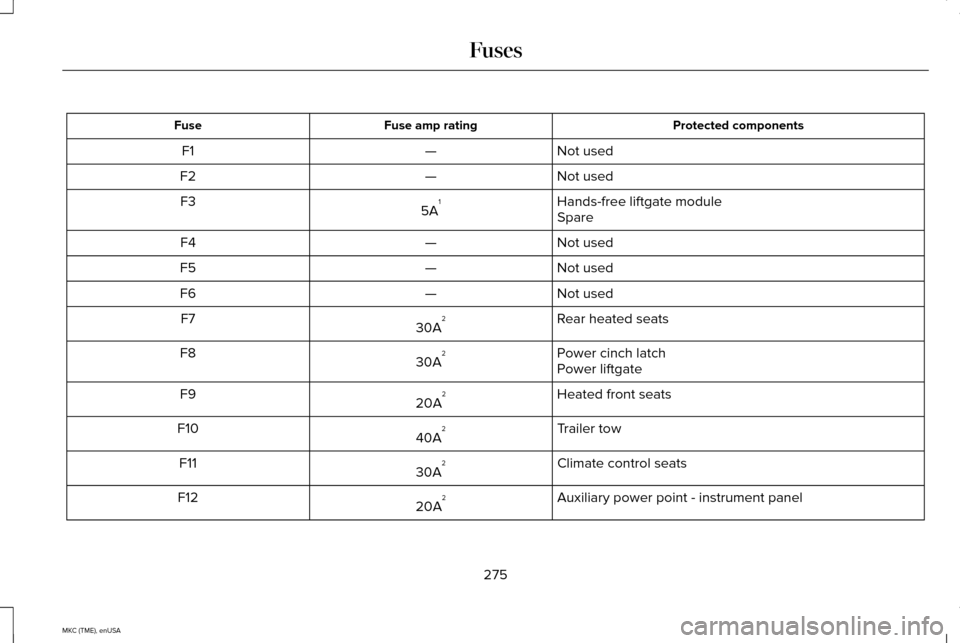
Protected components
Fuse amp rating
Fuse
Not used
—
F1
Not used
—
F2
Hands-free liftgate module
5A 1
F3
Spare
Not used
—
F4
Not used
—
F5
Not used
—
F6
Rear heated seats
30A 2
F7
Power cinch latch
30A 2
F8
Power liftgate
Heated front seats
20A 2
F9
Trailer tow
40A 2
F10
Climate control seats
30A 2
F11
Auxiliary power point - instrument panel
20A 2
F12
275
MKC (TME), enUSA Fuses
Page 296 of 490
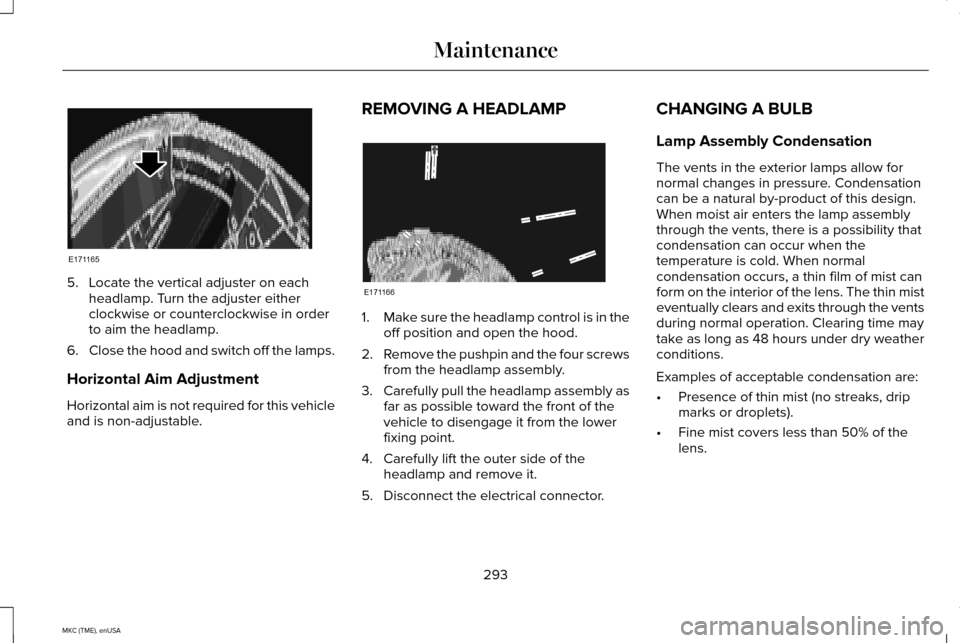
5. Locate the vertical adjuster on each
headlamp. Turn the adjuster either
clockwise or counterclockwise in order
to aim the headlamp.
6. Close the hood and switch off the lamps.
Horizontal Aim Adjustment
Horizontal aim is not required for this vehicle
and is non-adjustable. REMOVING A HEADLAMP
1.
Make sure the headlamp control is in the
off position and open the hood.
2. Remove the pushpin and the four screws
from the headlamp assembly.
3. Carefully pull the headlamp assembly as
far as possible toward the front of the
vehicle to disengage it from the lower
fixing point.
4. Carefully lift the outer side of the headlamp and remove it.
5. Disconnect the electrical connector. CHANGING A BULB
Lamp Assembly Condensation
The vents in the exterior lamps allow for
normal changes in pressure. Condensation
can be a natural by-product of this design.
When moist air enters the lamp assembly
through the vents, there is a possibility that
condensation can occur when the
temperature is cold. When normal
condensation occurs, a thin film of mist can
form on the interior of the lens. The thin mist
eventually clears and exits through the vents
during normal operation. Clearing time may
take as long as 48 hours under dry weather
conditions.
Examples of acceptable condensation are:
•
Presence of thin mist (no streaks, drip
marks or droplets).
• Fine mist covers less than 50% of the
lens.
293
MKC (TME), enUSA MaintenanceE171165 E171166